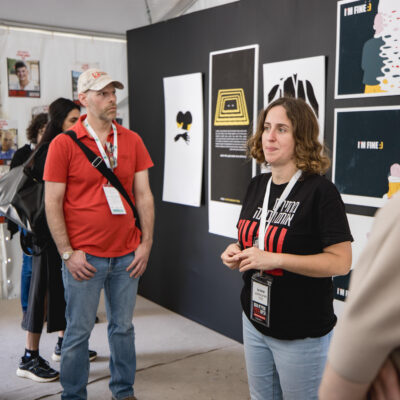10 Critical Insights for Successful Online Gatherings

By Lisa Colton, Emily Goodstein, and Miriam Brosseau
We write as huge swaths of Americans embark on a grand experiment of working from home, convening virtually and connecting without touching. With some collective experience in digital platforms for community building and education, and combined decades of experience working from home offices and with clients virtually, we want to share a few lessons to help you be successful as you move normal functions online and learn how to be productive and happy in this medium.
We have divided these recommendations into three categories: Technical smarts, cultural skillfulness and strategic value.
Technical Smarts
In a classroom or meeting space you know when and how to use your tools (white boards and chair layout, handouts and powerpoints). So too in an online space you need to know the tools you have at your disposal, why, when and how to use them.
The basics: Think about your backdrop – what’s behind you when you’re in a meeting? A colorfully painted wall or a color-sorted bookshelf is a lovely backdrop, or something that gives context to your work or hobbies. Lighting also matters. You want your face to be illuminated, and minimize light behind you (which feels like glare and makes your face dark). Finally, think about the angle of your camera. If you have a laptop on a low desk, you’re likely looking down into it, and others are seeing you against your ceiling. This always feels like vertigo to others. Insert a solid cookbook (may we suggest the Gefilte Manifesto or The Modern Jewish Baker?) under your laptop to bring your camera closer to eye level (for the vain of the social distancing set, raising your camera angle slightly above your eye level is also flattering). You may also consider investing in an external mouse and laptop, and propping your laptop up on a laptop stand – according to Emily’s massage therapist, this helps optimize for best posture and mouse/arm support.
Mute is your friend. Ideally, people know how to do this themselves, but because many people are new to this (and working from home may present new audio issues), you may have to be explicit and teach people. Generally for 6 or less we leave phone lines open, for 5-15 we allow people to arrive unmuted and chat a bit, and then when we start the agenda of meeting verbally ask everyone to mute themselves to minimize any background noise or feedback. For large groups, you may want to consider setting up your meeting to “mute on entry” and then verbally invite people to unmute to talk at any time. (Make sure to encourage people to jump into the conversation to minimize how much the mute function makes them feel restrained.) Seasoned online meeting folks toggle that mute button on and off constantly. If you are using Zoom and you’re the meeting host, you can also mute people individually if you sense their background noise is becoming an issue. It’s fine to say out loud that you’ll play this role, and acknowledge if you mute someone they are welcome to unmute themselves to speak up too. It’s about communal quality of life, not a gag order.
Chat is an extra bonus of online meetings. When used liberally and purposefully, it makes a 2 dimensional conversation become 3D. Passive participants can now also be active, and sharing of information and links is very easy. Teach people how to use the chat and practice getting comfortable with it. Use it to do a check in or introductions when people arrive. Ask questions and have people answer in the chat (and verbally acknowledge and integrate, even call on someone to expand on what they posted), encourage people to use it. Chat is also a great place to post the meeting agenda (if one exists) for all to see when the conversation begins so folks don’t have to go digging in their email for it. It’s not interrupting (when used well), it’s deepening.
For example, as the situation in Seattle intensified, Kavana Cooperative moved their Megillah reading online. Nearly 70 families logged in (multiple people in front of each computer), including people who would not have come to the live event (young kids, bedtime, parents of a Megillah reader who live in another state, etc.), PLUS, the snarky, silly running commentary and conversations in the chat added a whole other active, social element which would not have been possible with tushes in seats. (Notice in this photo who has well lit faces or are too backlit, who has a camera pointed at the ceiling, how a background gives you useful context or is distracting.)
Google Docs can also be a great tool to complement an online collaborative meeting to develop something together in real time, note taking, drafting documents, capturing next steps – just make sure the product will be used somehow.
Cultural Skillfulness
The first lesson is to recognize that you’re in a new environment, and thus many rules of engagement change. The changing social norms right now are making us all dizzy. A critical part of making online gatherings successful is helping people understand the social norms and cultural cues of the space.
- Don’t sacrifice the journey into a meeting. Everyone transitions into each gathering, whether it’s 2 people or 50, a board meeting, a staff meeting, a team brainstorm or a class. When you go from one Zoom meeting to the next, you lack the ritual of transition that’s needed to be fully present. As a leader, think about how to invite people to join your space. As Priya Parker says in The Art of Gathering, the gathering starts when you receive the invitation. Something as simple as “Bring a cup of tea and join us at 9:55 for the meeting which will start promptly at 10:00” allows people permission for both a physical and temporal transition.
Additionally, Miriam loves using this question inspired by Michael Bungary Stanier of “The Coaching Habit”: “On a scale of 1-7, how present are you? A 1 is ‘I have ten other tabs open and another meeting to hop onto in 15 minutes and the dog is barking and something just slammed in the next room and where is my kid…?’ and a 7 is ‘I am totally with you, this video chat is like a Vulcan mind-meld.’” Then get answers in the chat without judgment. It’s a chance for each person to consider their own sense of presence (and may consider what would help them go up a notch), and to let the facilitator calibrate accordingly.
- Intentionally set the tone and culture. When you arrive at an in-person gathering there are a multitude of cues that tell you about the culture of that group. How formal is the dress? How is the room setup? Are you greeted with formal handshakes or exuberant hugs (remember those?)? So too with online gatherings you need to pick a tone and culture and then give people plenty of cues about it. Some of this norm-setting can happen in advance – the tone of your emails (“Looking forward to seeing you from the waist up – totally acceptable to be in fuzzy slippers under your desk!”); the emotional tenor; and being explicit about your tools (use of mute, chat, etc. from above).
- Once everyone knows the social norms, and knows that everyone else is operating from the same social norms, then you can move on to a productive conversation.
- Connect with your people. In person, we get a chance to connect and catch up. Online, it’s very easy to just jump into the agenda without this interpersonal layer. However, when we’re online all the time, and further isolated in the rest of our lives, this interpersonal layer becomes even more critical. Consider adding a personal component to the meeting agenda, especially during these next few days and weeks as we all settle into this new normal. There is nothing wrong with five minutes of a 60 minute meeting used to intentionally check in about where participants are in their hearts and heads. It’s also OK to put boundaries on that check in so the conversation doesn’t descend into the news cycle and anxiety-provoking updates. An example might be “What’s something you’re doing to take care of yourself physically during these times?” or “What’s a new connection you’ve made this week that may not have happened if not for these unusual times?”
- Passing the mic is different online. In person, we have a lot of cues about taking turns speaking. Eye contact, leaning forward, raising your hand a few inches off your knee, etc. Online, we lack that body language, plus a fraction of a second delay in audio means we often end up talking over each other, or stuck in a polite “no, you go ahead” “no no, you go” (remember this Portlandia moment?). As a good online host, you can help avoid this by calling on people, posting an order for comments or check ins in the chat, and paying particularly close attention to faces and behavior. If someone unmutes and mutes, unmutes and mutes they probably have something to say but don’t want to interrupt or cut someone off. At the next pause, ask them if they have something to add.
- Make space for lightness. While this may feel like a sprint in the moment, it’s going to be the longest endurance challenge most of us have ever faced. While we are working hard, pivoting, and carrying personal, familial and professional stress, let’s remember the need to also bring some levity and fresh air into our worlds regularly. Lisa’s been hosting online cocktail parties over Zoom most evenings – a kind of “Shabbat” from the rest of reality right now. Bring your beverage of choice (social distancing cocktail ideas here!) and throw out a discussion topic to direct people to the tone you want to cultivate. “What’s a crack where the light came in (thx Leonard Cohen) for youthis week?” You can send out specific invitations or have an open house (which was nice because it was a little burst of joy every time someone new logged in).
Strategic Value
While this is a stressful moment, plenty of new opportunities abound! Step back and see what opportunities this situation might present and how you can pivot what you do or how you do it to take advantage.
- While you may opt to move some things online – like streaming Shabbat services for example – we also encourage you to think outside the proverbial box. People who are more isolated now are going to be hungry to connect with each other. How might you support small groups coming together for meaningful conversation? How could small discussion groups, book clubs, or even families with toddlers lighting candles together on Friday night (if consistent with your observance) create new, rich social connections that will pay further dividends once this is all behind us? How are older members of your community or those who are immune-compromised and thus need to be even further isolated staying connected? This week a Kavana partner who is a parent coach led a discussion on managing with kids at home during this time. Staff can help create a platform for such connection, but you can invite and empower others to initiate and convene themselves to decrease weight on staff shoulders (and to cultivate new leaders at the same time).
- Not everything that can be moved online should be moved online. Video is not always the answer. There is a gut instinct to take what would have been a committee meeting of the board held in person and turn it into a video meeting. But perhaps it makes sense to ask yourself, “Do we need this meeting at all now? Should it be postponed or reimagined?” Could this PTA discussion be handled over email with a link to a SurveyMonkey survey? Should we opt for a phone call or text message chain/WhatsApp group vs Google Hangout or Zoom meeting? During a time when childcare is more limited and community members are adjusting to the new rules of the road, the chance to be more respectful of schedules and perhaps even more efficient is front and center.
Finally, we want to encourage you to use each other. Some of us have more experience with online gatherings than others. If you have questions, ask. If you see someone who could use a little coaching, offer it (and if you’re being offered some tips, try to receive it with love rather than being offended). Who are the members of your community and your colleagues who work online often? Or your friends who have worked from home for years, and professionals who have specific strategic and/or communications expertise to help you take advantage of the moment for minimal disruption and maximum benefit. A small amount of time invested in leveraging this wisdom will save you a ton of time and a steep learning curve.
The more we see moving into online spaces as an opportunity to learn and experiment and (re)connect in new and interesting ways, and the more we approach this with a growth mindset, the better off we’re going to be.
Have other tips to suggest? PLEASE share them in the comments! We all want to learn from your experience!
Lisa Colton is the president of Darim Online and Darim Consulting, LLC. “Darim” comes from lamed/dov/vuv/raish – to dwell or inhabit. She has been consulting in the Jewish community about strategic and successful use of technology for mission-centered work for 20 years. She’s been hosting a new nightly cocktail hour on Zoom for one full week and it’s contributing to her sanity while social distancing in the Seattle epicenter.
Emily Goodstein combines her love of digital media with her extensive grassroots organizing background to help nonprofits scale quickly and sustainably. As the CEO of Greater Good Strategy, Emily and her team of 30 star digital strategists help organizations fulfill their missions, leveraging a multichannel approach to meld offline and online tools. She’s currently social distancing in Washington, DC with her newish husband, Ron.
Miriam Brosseau is the principle of Tiny Windows Consulting, an organizational strategy and communications consultancy. She’s a master storyteller and online facilitator, and has multiple guitars hanging on the walls as the backdrop in her home office in Chicago.

 Add EJP on Google
Add EJP on Google










